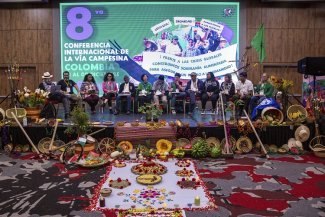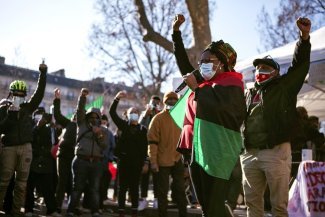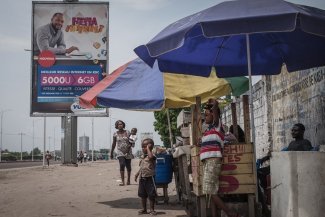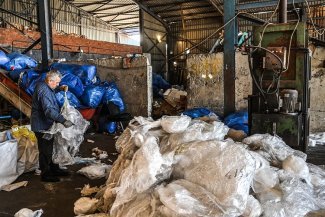
Small coca farmers from Tumaco will not substitute their crops until the government concludes an agreement with each grower.
José Hilton Ortiz has to paddle for four hours in his canoe to reach his small district from the closest city. The same journey takes drug traffickers less than an hour by speedboat. In Tumaco, the region with the highest number of coca plantations in Colombia, growers are resisting pressure from the government to eradicate their coca production, which has grown by 60 per cent over the last two years, for want of alternatives.
“We are willing to take part in the voluntary substitution of illicit crops, but we need a commitment from the state, which has neglected us so far,” says coca grower José, regarding the government plans to eradicate 50,000 hectares of coca this year, as agreed under the peace accords with the FARC.
Despite the willingness of these farmers to replace their crops, the army is still conducting its forced eradication operations. “A number of helicopters land, around 50 anti-narcotics police descend from them and within 20 minutes they have destroyed the plantation,” says José, about a practice that has led to clashes. “If anyone gets in their way, a terrifying amount of bullets fly, to shouts of ‘You are guerrillas’, and there is nothing we can do.” Around 5,000 hectares have been eradicated this year, including 424 in Tumaco. Three helicopters flew over the area on reconnaissance missions whilst Equal Times was holding the interviews.
“We’ll lay our lives on the line to stop them from killing our plants. We won’t let them destroy our crops without offering us solutions,” exclaims one of the raspachines (coca pickers). The coca leaf is the main livelihood of these Afro-descendant communities from the Colombian South Pacific. José earns four times more from coca than from other crops such as banana or cacao. He makes 40 million pesos a year (around US$13,800) from his two hectares of coca, which can be harvested every three months. A banana plantation would bring him little over 10 million pesos a year (around US$3,500).
Neglect and drug trafficking pushes up coca production
The substantial earnings combined with the lack of opportunities for these campesinos has led to an increase in coca planting, despite the huge amounts of aid invested since 2000 by the United States under ‘Plan Colombia’, designed to combat drug trafficking. According to a report by the US Department of State, coca production has risen by 60 per cent over the last two years, reaching an all-time high of 188,000 hectares. Colombia is the world’s leading cocaine producer, surpassing Peru and Bolivia combined, which are next on the list.
The United States has warned Colombia about a dramatic increase in coca plantations, which, according to the White House, is fuelling drug trafficking. In spite of this criticism, at the beginning of March, in neighbouring Bolivia, President Evo Morales approved the expansion of the surface area where the crop can be grown to produce legal coca products, a move expected to increase the country’s agricultural earnings by 8.1 per cent.
In Colombia, the government itself has recognised the magnitude of the challenge posed by replacing the coca model. The director of the Agency for the Substitution of Illicit Crops, Eduardo Díaz, explained that the rise in coca production is owed to the lack of alternatives and that failing to remove these crops is a threat to peace.
Voluntary substitution is still in its initial phase. In Tumaco, very little progress is being made in the negotiations, owing to strong resistance among growers. “We won’t deal with intermediaries. They always betray us. Agreements have been made, but only on a handshake, and then they betray us,” says José, regarding the mistrust towards the state in one of the most neglected regions of the country.
According to Rear Admiral Serrano, military chief of the task force against drug-trafficking, ‘Poseidón’: “The increase in illicit crops goes hand in hand with the lack of socio-economic opportunities in Tumaco, and dates back decades.”
The problem has been compounded by the boom in the drug trade, reinforced by the arrival of armed groups that have occupied the place left by the FARC (both in physical and business terms), since it began demobilising in the middle of last year.
“From the moment when the peace process entered its final phase, new groups linked to drug trafficking have been recruiting more growers, so the business is being kept going. The more trade there is, the more production there is,” Célimo Cortés, head of the local Afro-descendant community, tells Equal Times. Tumaco, known as the ‘Pearl of the Pacific’, is the source of 60 per cent of the cocaine that leaves Colombia for the United States. Peru can be reached via its coastal mangroves. The thick vegetation makes it easy to hide: it is a haven for drug traffickers.
The coca growers are the first and the most vulnerable link in this chain. “With the disappearance of the FARC, which protected us as well as possible, we started to hear about groups that are killing people and no one knows what their intentions are. That is why we are shaking with fear,” says José. Tumaco continues to be one of the Colombian cities with the highest levels of violence since the peace was signed.
With coca came the problems
The arrival of coca seeds to the district of Santa Rosa around the year 2000 marked the start of the problems. José warned his neighbours about it at the first meeting on the matter: “Coca brings with it the guerrilla and then the paramilitaries,” José recalls saying.
“We used to get by before, because the mentality of the older people was that we should all stay in the countryside, but now the young people want their children to get out of here and get qualifications,” says Manuel, a coca picker.
For now, coca is the only guarantee of a decent future for these communities. That is why they have been resisting for years against the state’s fight to do away with their crops.
“A couple of years ago, they were still using aerial fumigation to eradicate the crops. The poison they sprayed used to kill other crops and livestock, as well as making people ill and giving them allergies because it would end up in the river that we drink from, given that we have no running water,” recalls José. Several NGOs denounced the harmful effects of these fumigations on the local people.
The peace agreements have succeeded in stopping these operations, although forced eradication remains in place. “They have signed deals with the FARC and they are leaving, but we are staying and our needs remain the same. The government has always ignored us,” complains José, who warns of the violence that could break out it fails to implement voluntary crop substitution: “If they keep their word, I will rip out the plants myself, but no one is prepared to die of hunger here. The government gets rid of one revolutionary group and then pushes people to form new ones.”









